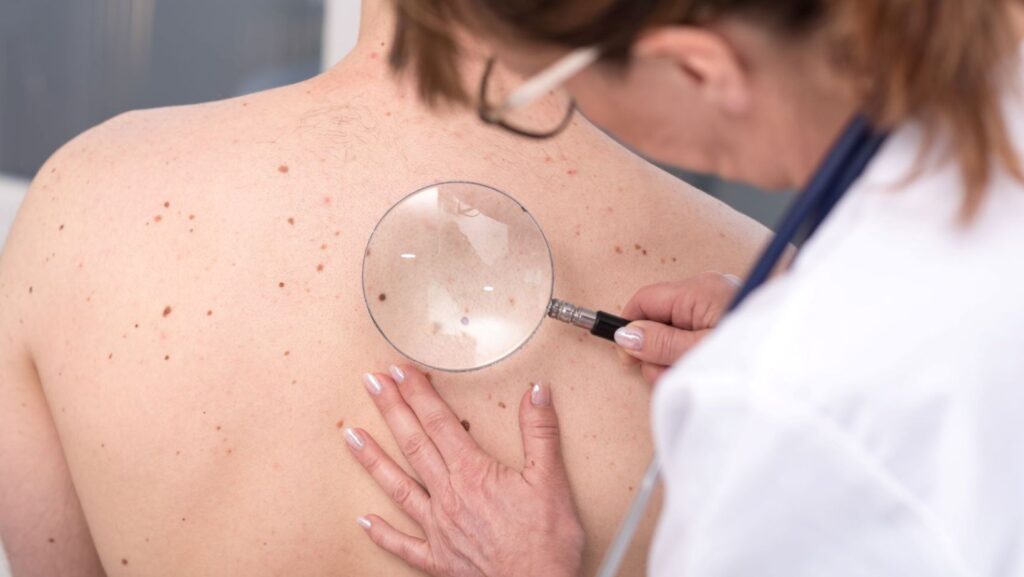Skin cancer is one of the most prevalent forms of cancer, yet it’s also highly preventable and treatable when detected early. If you’re mindful of your health, you’re probably already taking measures to protect your skin from the sun’s harmful rays.
However, sun protection alone might not be sufficient. With rising skin cancer rates, incorporating routine skin cancer screenings into your healthcare regimen can make a significant difference.
Step 1: Know the Risk Factors
Risk factors for skin cancer are characteristics or behaviors that increase your likelihood of developing the disease. By identifying them, you can take proactive steps toward skin cancer prevention and ensure that you’re receiving the right level of care.
- History of Sunburns: Frequent or severe sunburns, especially in youth, increase your risk of skin cancer due to cumulative UV damage.
- Fair Skin: Fair-skinned individuals are more prone to sunburns and, consequently, have a higher risk of developing skin cancer due to lower melanin protection.
- Family History of Skin Cancer: A family history of skin cancer, particularly melanoma, can indicate a genetic predisposition, increasing your personal risk.
- Presence of Many Moles: Having many moles, especially atypical ones, raises your likelihood of melanoma, making regular monitoring crucial.
- Exposure to Tanning Beds: Using tanning beds exposes you to concentrated UV radiation, significantly increasing your risk of all types of skin cancer.
- Personal History of Skin Cancer: If you’ve had skin cancer before, your risk of developing it again is higher, necessitating more frequent check-ups.
- Immune System Suppression: A weakened immune system reduces your body’s ability to fight off cancerous cells, increasing your susceptibility to skin cancer.
Understanding your personal risks and incorporating regular skin cancer screenings helps you take control of your health and reduce the likelihood of developing skin cancer.
Step 2: Perform Monthly Self-Examinations
Monthly self-examinations are a crucial step in the early detection of skin cancer. Begin by standing in front of a full-length mirror in a well-lit room. A handheld mirror can be useful for checking areas that are hard to see, such as your back, the back of your legs, and your scalp.

Systematically examine your entire body, starting from your scalp and moving down to your toes. Be thorough, checking commonly overlooked areas like your back, the soles of your feet, and between your toes.
The ABCDE rule is a valuable guide for identifying potential signs of skin cancer:
- Asymmetry: If one half of the mole looks different from the other half, this lack of symmetry could indicate a problem.
- Border: Moles with edges that appear irregular, ragged, or blurred may be warning signs of skin cancer.
- Color: A mole that displays multiple colors, such as varying shades of brown, black, pink, red, white, or blue, should be examined by a healthcare professional.
- Diameter: Moles larger than 6 millimeters (about the size of a pencil eraser) are more likely to be concerning, though smaller moles can also be suspicious.
- Evolving: Any mole that is changing in size, shape, or color over time should be evaluated, as this could be a sign of skin cancer.
Document any new or changing spots with photographs to track their progression over time. This proactive approach allows you to catch potential issues early when they are most treatable.
Step 3: Schedule Regular Professional Skin Exams
In addition to self-examinations, it’s important to schedule regular professional skin exams with a dermatologist. The frequency of these exams depends on your personal risk factors, but an annual check-up is recommended for most individuals.

During the exam, your dermatologist will perform a thorough inspection of your skin, often using a dermatoscope—a specialized tool that magnifies and illuminates the skin, providing a closer look at moles and other spots.
This detailed examination helps identify any suspicious changes that may not be visible to the naked eye. It’s also an opportunity to discuss any concerns or changes you’ve noticed with your dermatologist, ensuring that nothing is overlooked.
Step 4: Follow Up on Suspicious Findings
If you or your dermatologist notice any suspicious spots during your screenings, it’s essential to follow up immediately. Early action can make a significant difference in treatment outcomes.
Your dermatologist may recommend a biopsy, which involves removing a small sample of the suspicious area for further examination in a laboratory. This step is crucial for determining whether the spot is cancerous.
Based on the biopsy results, your dermatologist will advise you on the next steps, which may include further treatment, such as surgical removal of the lesion, or a more frequent monitoring schedule to ensure that any future changes are caught early.
Step 5: Utilize Advanced Screening Technologies
Advancements in technology have made skin cancer screening more accurate and comprehensive. If you have a large number of moles or other risk factors, ask your dermatologist about advanced screening tools like digital dermoscopy or total body photography.
Digital dermoscopy allows for the detailed examination of individual moles over time, helping to detect subtle changes that may indicate skin cancer.
Total body photography involves taking a series of images of your entire skin surface, which can be compared over time to spot new or changing lesions.
These technologies are particularly useful for those at higher risk of skin cancer, as they provide a detailed record that can aid in early detection and treatment.
Final Thoughts
Proactively screening for skin cancer is vital to protecting your health. By knowing your risk factors, conducting monthly self-exams, scheduling regular dermatologist visits, and promptly addressing any concerns, you increase your chances of early detection and effective treatment.
Remember that consistent vigilance and early action are key, so make these practices part of your routine to safeguard your skin and overall well-being.
